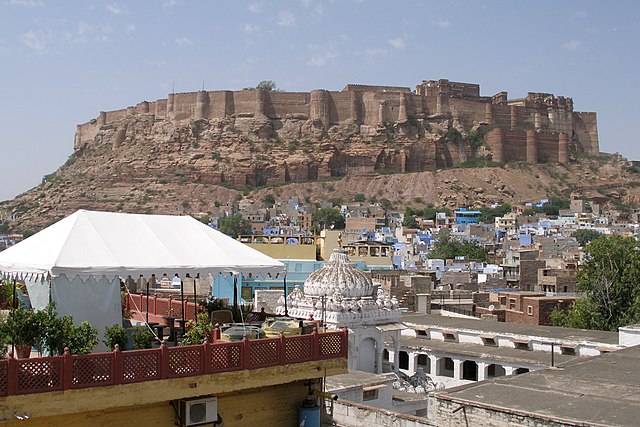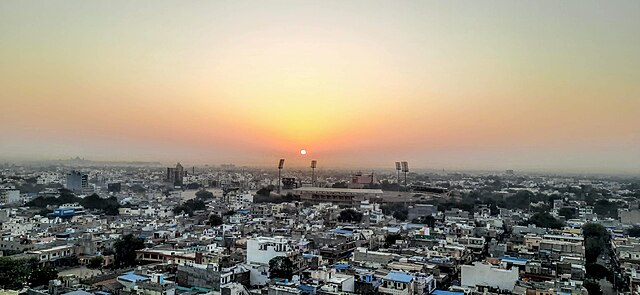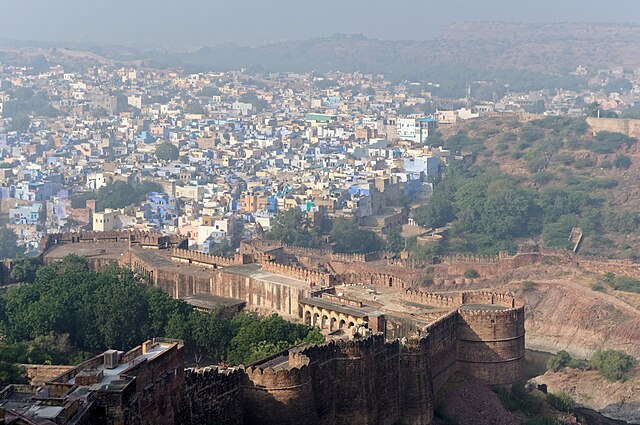Ever wondered what it’s like to wander through the vibrant streets of Jodhpur under a blazing sun or a starry desert sky? The weather in Jodhpur, Rajasthan’s Blue City, is as dynamic as its culture. From scorching summers to crisp winters, Jodhpur’s climate shapes the experience of every traveler and local. In this guide, I’ll take you through the ins and outs of Jodhpur’s weather, offering insights, tips, and a peek into what makes this desert city’s climate so unique. Let’s dive into the heart of Jodhpur’s weather patterns!
Why Jodhpur’s Weather Matters
Jodhpur’s weather isn’t just a backdrop—it’s a character in the city’s story. Whether you’re planning to explore the majestic Mehrangarh Fort or stroll through the bustling Sardar Market, the climate influences your itinerary, clothing choices, and even your mood. The city’s desert location in Rajasthan means extreme temperatures, unpredictable monsoons, and a distinct seasonal rhythm. Understanding Jodhpur’s weather helps you make the most of your visit, ensuring you’re prepared for whatever Mother Nature throws your way.
A Desert Climate: What to Expect
Jodhpur sits in the Thar Desert, which gives it a hot, arid climate. Think of it like a giant oven in summer and a cool, open-air lounge in winter. Daytime temperatures can swing wildly from night, and humidity levels vary with the seasons. This desert setting means you’ll experience intense heat, occasional dust storms, and rare but dramatic rainfall. If you’re picturing endless sand dunes and camels, you’re not far off—just add vibrant blue houses and historic forts to the scene!
Breaking Down Jodhpur’s Seasons

Jodhpur’s weather unfolds in three main acts: summer, monsoon, and winter. Each season has its own personality, bringing unique challenges and charms. Let’s break them down to help you plan your adventure or simply understand what life in Jodhpur feels like year-round.
Summer in Jodhpur: April to June
Summer in Jodhpur is not for the faint-hearted. From April to June, temperatures soar, often hitting 45°C (113°F) or more. It’s like stepping into a sauna that stretches across the city. The sun blazes relentlessly, and the air feels dry and dusty. Locals adapt by staying indoors during peak afternoon hours, sipping cold lassi, and wearing light, breathable cotton clothes. If you visit during summer, early mornings and late evenings are your best friends for sightseeing.
Tips for Surviving Jodhpur’s Summer Heat
How do you beat the summer sizzle? Hydration is key—carry a water bottle everywhere. Opt for loose, light-colored clothing, and don’t skip the sunscreen or a wide-brimmed hat. Plan indoor activities, like visiting the Umaid Bhawan Palace Museum, during the hottest hours. And here’s a pro tip: try a refreshing kulfi (Indian ice cream) to cool off while soaking in the city’s charm.
Monsoon in Jodhpur: July to September
When the monsoon arrives in July, Jodhpur breathes a collective sigh of relief. The rains transform the arid landscape, painting it with patches of green. Temperatures drop to a more bearable 30-35°C (86-95°F), but humidity spikes. Rainfall is sporadic—think sudden downpours followed by clear skies. The city’s forts and palaces look magical against dramatic, cloudy backdrops, but flash floods and muddy streets can pose challenges.
Embracing the Monsoon Magic
Monsoon in Jodhpur is like a fleeting romance—intense and unforgettable. Pack a lightweight raincoat and sturdy shoes to navigate wet streets. Visit rooftop cafes to watch the rain over the city’s blue houses, or head to Mandore Gardens for a lush, post-rain stroll. Just keep an eye on weather updates, as heavy rains can disrupt travel plans.
Winter in Jodhpur: October to March
Winter is Jodhpur’s golden season. From October to March, temperatures range from 10-25°C (50-77°F), making it perfect for exploring. The days are sunny and pleasant, while nights can get chilly, especially in December and January. It’s like the desert decides to throw a party, inviting clear skies and cool breezes. This is peak tourist season, so expect lively festivals, bustling markets, and crowded attractions.
Making the Most of Jodhpur’s Winter
Winter in Jodhpur feels like a warm hug after the summer’s heat. Pack layers for chilly evenings, and plan outdoor adventures like desert safaris or zip-lining at Mehrangarh Fort. Don’t miss the Rajasthan International Folk Festival (RIFF) in October, where music and culture light up the city. Winter is also ideal for savoring hot chai and spicy Rajasthani thalis at local eateries.
Monthly Weather Breakdown

Want a quick snapshot of Jodhpur’s weather? Here’s a month-by-month guide to help you plan. Each month has its quirks, from blistering heat to refreshing showers.
January to March: Cool and Comfortable
The year kicks off with crisp mornings and sunny afternoons. January is the coldest month, with lows around 10°C (50°F). By March, temperatures climb to 30°C (86°F), hinting at summer’s approach. These months are ideal for sightseeing, with clear skies and minimal rain.
July to September: Rainy and Humid
Monsoon season brings relief from the heat but adds humidity. July and August see the most rain, with occasional thunderstorms. September tapers off, transitioning to drier, warmer days. Expect vibrant greenery and fewer crowds, but be ready for wet conditions.
October to December: Perfect Weather
October ushers in winter, with pleasant days and cool nights. November and December are chilly but sunny, with highs around 25°C (77°F). These months are packed with tourists and festivals, making Jodhpur feel alive and festive.
How Weather Shapes Jodhpur’s Culture
Jodhpur’s weather isn’t just about temperature—it’s woven into the city’s traditions, festivals, and daily life. The climate has shaped everything from architecture to cuisine, creating a unique cultural tapestry.
Architecture Built for the Climate
Ever noticed how Jodhpur’s forts and havelis have thick walls and shaded courtyards? These designs keep interiors cool during scorching summers. The blue-painted houses, which give Jodhpur its nickname, reflect sunlight, reducing heat absorption. It’s like the city was engineered to outsmart the desert sun!
Festivals Timed with the Seasons
Jodhpur’s festivals align with its weather. Winter brings vibrant events like RIFF and the Marwar Festival, when cool temperatures draw crowds. Monsoon season inspires celebrations like Teej, where locals pray for rain and prosperity. These festivals are like the city’s heartbeat, pulsing with the rhythm of the seasons.
Weather-Related Challenges in Jodhpur

Jodhpur’s weather isn’t always picture-perfect. The desert climate brings challenges like extreme heat, water scarcity, and occasional storms. Let’s explore these hurdles and how the city copes.
Heatwaves and Water Scarcity
Summer heatwaves can be brutal, pushing temperatures past 50°C (122°F) in extreme cases. Water scarcity is a persistent issue, as the desert lacks natural water sources. Locals rely on rainwater harvesting and government-supplied water, while tourists are encouraged to conserve. It’s a reminder of how precious every drop is in this arid land.
Dust Storms and Monsoon Floods
Dust storms, or “andhi,” can sweep through Jodhpur in summer, reducing visibility and coating everything in sand. Monsoon floods, though rare, can disrupt roads and railways. These natural dramas add a wild edge to Jodhpur’s weather, keeping residents and visitors on their toes.
Planning Your Visit: Best Time to Go
So, when’s the best time to visit Jodhpur? It depends on your vibe. Winter (October to March) is the crowd favorite for its mild weather and festive energy. Monsoon (July to September) offers a quieter, greener experience, while summer (April to June) is for budget travelers who don’t mind the heat. Each season has its perks, so pick what suits your style!
Packing Tips for Jodhpur’s Weather
Packing for Jodhpur is like preparing for a desert adventure. Bring lightweight cotton clothes for summer, a raincoat for monsoon, and layers for winter. Sunglasses, sunscreen, and a reusable water bottle are must-haves year-round. And don’t forget comfortable shoes for exploring those cobbled streets!
Weather Forecasts and Staying Updated
Want to stay ahead of Jodhpur’s weather? Check reliable sources like AccuWeather or the India Meteorological Department (IMD) for forecasts. Local news and social media, like posts on X, often share real-time updates about dust storms or rain. It’s like having a weather crystal ball to guide your plans!
Jodhpur Weather and Climate Change
Climate change is leaving its mark on Jodhpur. Rising temperatures, erratic monsoons, and prolonged droughts are becoming more common. The city is adapting with solar energy projects and water conservation efforts, but the future remains uncertain. It’s a sobering reminder to travel responsibly and support sustainable practices.
Conclusion: Embracing Jodhpur’s Weather
Jodhpur’s weather is a rollercoaster of extremes, from blazing summers to chilly winters and dramatic monsoons. It shapes the city’s culture, challenges its residents, and adds flavor to every visitor’s experience. Whether you’re chasing winter festivals, monsoon greenery, or summer deals, understanding Jodhpur’s climate helps you embrace its magic. So, pack your bags, check the forecast, and get ready to fall in love with the Blue City’s wild, wonderful weather!
FAQs About Jodhpur Weather
1. What is the best time to visit Jodhpur?
The best time to visit Jodhpur is winter (October to March), when temperatures are mild (10-25°C) and perfect for sightseeing. It’s also festival season, so the city buzzes with energy.
2. Does Jodhpur get a lot of rain?
Jodhpur receives limited rainfall, mostly during the monsoon (July to September). Expect sporadic showers, with occasional heavy downpours that can cause flash floods.
3. How hot does it get in Jodhpur during summer?
Summer (April to June) can be scorching, with temperatures often exceeding 45°C (113°F). Heatwaves may push it higher, so stay hydrated and avoid midday sun.
4. Is Jodhpur’s weather affected by climate change?
Yes, Jodhpur faces rising temperatures, erratic monsoons, and water scarcity due to climate change. The city is adopting sustainable practices to cope.
5. What should I pack for a winter trip to Jodhpur?
For winter, pack layers like sweaters and jackets for chilly nights, along with comfortable shoes, sunglasses, and sunscreen for sunny days.

